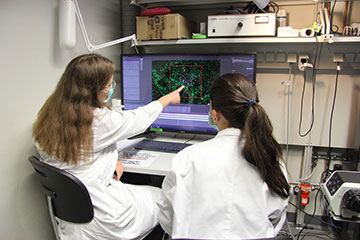![]()
The FLUCS system for noninvasive photomanipulation of cells. [Image: Rapp OptoElectronic]
The Germany-based company Rapp Optoelectronic will commercially develop a new laser technology called FLUCS (focused light-induced cytoplasmic streaming) that came out of the Max Planck Institute of Molecular Cell Biology and Genetics (MPI-CBG), Germany. According to the researchers, FLUCS—a method of photomanipulation that makes it possible to influence movements in cells and embryos—allows noninvasive control of cells for the first time.
Joint technology development
The FLUCS technique was developed by an MPI-CBG research team led by Mortiz Kreysing (now at the Karlesruhe Institute of Technology, Germany) as part of a cooperation with Rapp Optoelectronic. After that successful joint development and a completed license agreement, the FLUCS technology was transferred from MPI-CBG to Rapp. The agreement was unveiled in a press release from Max Planck’s technology transfer organization, Max Planck Innovation, which links researchers with industry partners.
Rapp OptoElectronic is now offering FLUCS as a market-ready product, in the form of an additional module for high-resolution microscopes, to researchers and industrial users. A pilot system is located in the Light Microscopy Facility of the MPI-CBG in Dresden, Germany, where it is available for use by scientists both inside and outside MPI.
“We are pleased that the successful cooperation between the MPI for Molecular Cell Biology and Genetics and Rapp OptoElectronic GmbH will bring first-class commercial products to the market that are far superior to the current state of the art,” said Bernd Ctortecka, patent and license manager at Max Planck Innovation, in a press release.
Noninvasive manipulation

Researchers work on the FLUCS system in the Light Microscopy Facility at the Max Planck Institute for Molecular Cell Biology and Genetics (MPI-CBG) in Dresden, Germany. [Image: MPI-CBG]
Cell biologists and medical researchers rely on imaging to analyze cells, and the ability to manipulate the cells under controlled conditions is key to understanding their processes and relationships. However, the tools that scientists use to influence cell components often disturb the sample and affect the results.
In FLUCS, laser beams are used to selectively induce a thermal field in a cell’s cytoplasm, which changes the density and viscosity of the liquid medium and causes a flow. The biomolecules within the cytoplasm are set in motion directly without modifying the sample, as is necessary using methods like optical tweezers. This leaves the molecules free to interact with their environment.
The MPI-CBG researchers report that they were able to use FLUCS in living worm embryos to generate controlled currents that moved biomolecules to different areas. This manipulation allowed them to examine the importance of cytoplasm movement for the polarization of oocytes, and they write that the technique could allow better understanding of embryonic development and disorders.
Wide applicability claimed
“FLUCS makes microscopy interactive and opens up new possibilities for a variety of research areas,” said Ctortecka. Rapp Optoelectronic notes on its website that the technique could have a wide variety of applications, not only in cell biology, medical research and biophysics but also in microfluidics.
“FLUCS fills a gap in the previously available micromanipulation techniques to study the causes and consequences of intracellular movement,” said Sven Warnck, Rapp Optoelectronic’s managing director. “Directed liquid flows are induced by moderately warming up the sample with a laser spot. Their path can be easily specified individually using the user-friendly software, for example as a line, circle or free form.”
